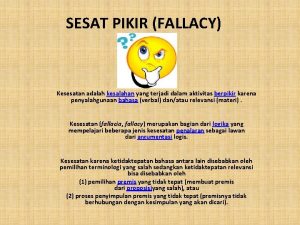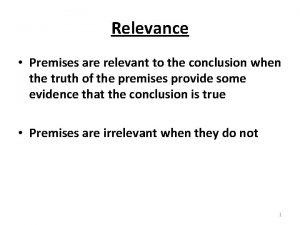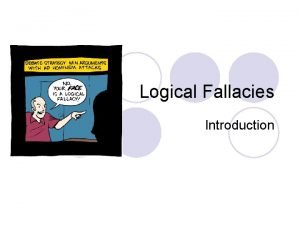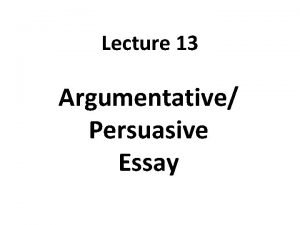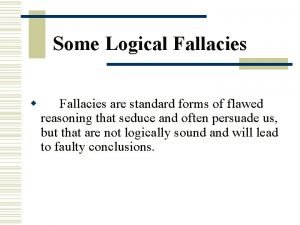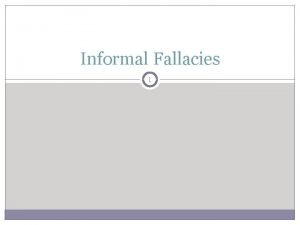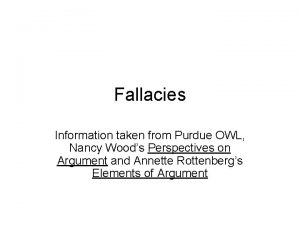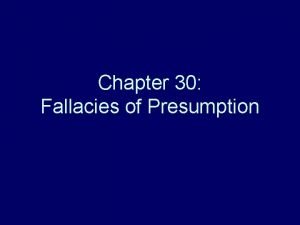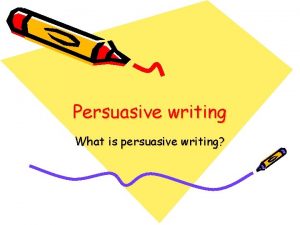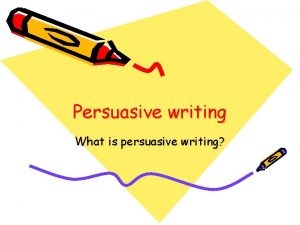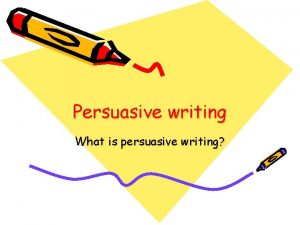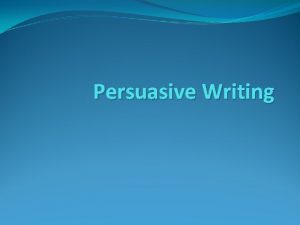Fallacies for Persuasive Writing Part I Ad Hominem






























- Slides: 30

Fallacies for Persuasive Writing Part I Ad Hominem Appeal to Emotion Appeal to Authority Bandwagon Straw Man Slippery Slope

There are two main types of arguments: Deductive ----- Inductive.

DEDUCTIVE ARGUMENT In a deductive argument, the premises are intended to provide support for the conclusion that is so strong that, if the premises are true, it would be impossible for the conclusion to be false.

A sample form of a Deductive Argument is a syllogism. All humans are mortal. Tina is a human. Therefore, Tina is mortal.

INDUCTIVE AGRUMENT An inductive argument is an argument in which it is thought that the premises provide reasons supporting the probable truth of the conclusion. In an inductive argument, the premises are intended only to be so strong that, if they are true, then it is unlikely that the conclusion is false.

Inductive Argument Premise 1 Most American cats are domestic house cats. 2 Bill is an American cat. 3 Bill is domestic house cat.

A fallacy is an error in reasoning. This differs from a factual error, which is simply being wrong about the facts. To be more specific, a fallacy is an "argument" in which the premises given for the conclusion do not provide the needed degree of support.

Ad Hominem means against the man or against the person. An Ad Hominem is a general category of fallacies in which a claim or argument is rejected on the basis of some irrelevant fact about the author of or the person presenting the claim or argument.

Person A makes claim X. Person B makes an attack on person A. Therefore A's claim is false. The reason why an Ad Hominem (of any kind) is a fallacy is that the character, circumstances, or actions of a person do not (in most cases) have a bearing on the truth of a claim being made (or the quality of the argument being made). Example of Ad Hominem Bill I believe that abortion is morally wrong. Dave Of course you would say that, you're a priest. Bill What about the arguments I gave to support my position ? Dave Those don't count. You're a priest, so you have to say that abortion is wrong. Further, you are just a lackey to the Pope, so I can't believe what you say.


An Appeal to Authority Person A is (claimed to be) an authority on subject S. Person A makes claim C about subject S. Therefore, C is true.

This fallacy is committed when the person in question is not a legitimate authority on the subject. More formally, if person A is not qualified to make reliable claims in subject S, then the argument will be fallacious.

In such cases the reasoning is flawed because the fact that an unqualified person makes a claim does not provide any justification for the claim. The claim could be true, but the fact that an unqualified person made the claim does not provide any rational reason to accept the claim as true.


An Appeal to Emotion a fallacy with the following structure: Favorable emotions are associated with X. Therefore, X is true. This fallacy is committed when someone manipulates peoples' emotions in order to get them to accept a claim as being true. If the favorable emotions associated with X influence the person to accept X as true because they "feel good about X, " then he has fallen prey to the fallacy.

This fallacy is actually an extremely effective persuasive device. As many people have argued, peoples' emotions often carry much more force than their reason. Logical argumentation is often difficult and time consuming and it rarely has the power to spurn people to action. It is the power of this fallacy that explains its great popularity and wide usage. However effective it is in practice, it is still a fallacy.


BANDWAGON The Bandwagon is a fallacy in which a threat of rejection by one's peers (or peer pressure) is substituted for evidence in an "argument. " This line of "reasoning" has the following form: Person P is pressured by his/her peers or threatened with rejection. Therefore person P's claim X is false. This line of "reasoning" is fallacious because peer pressure and threat of rejection do not constitute evidence for rejecting a claim.

Example of Bandwagon Bob says that he likes the idea that people should work for their welfare when they can. His friends laugh at him, accuse him of fascist leanings, and threaten to ostracize him from their group. He decides to recant and abandon his position to avoid rejection.

Example of Bandwagon Bill I like classical music and I think it is of higher quality than most modern music. Jill That stuff is for old people. Dave Yeah, only real woosies listen to that crap. Besides, Anthrax rules! It Rules!" Bill Well, I don't really like it that much. is much better. " Anthrax


Straw Man The Straw Man fallacy is committed when a person simply ignores a person's actual position and substitutes a distorted, exaggerated or misrepresented version of that position. This sort of "reasoning" has the following pattern: Person A has position X. Person B presents position Y (which is a distorted version of X). Person B attacks position Y. Therefore X is false/incorrect/flawed.

This sort of "reasoning" is fallacious because attacking a distorted version of a position simply does not constitute an attack on the position itself. One might as well expect an attack on a poor drawing of a person to hurt the person.

Examples of Straw Man Senator Jones says that we should not fund the attack submarine program. I disagree entirely. I can't understand why he wants to leave us defenseless like that. Bill and Jill are arguing about cleaning out their closets: Jill We should clean out the closets. They are getting a bit messy. Bill Why, we just went through those closets last year. Do we have to clean them out everyday? " Jill I never said anything about cleaning them out every day. You just want too keep all your junk forever, which is just ridiculous.

Be charitable to your opponents. State arguments as strongly, accurately, and sympathetically as possible. If you can knock down even the best version of an opponent's argument, then you've really accomplished something.


Slippery Slope The Slippery Slope is a fallacy in which a person asserts that some event must inevitably follow from another without any argument for the inevitability of the event in question. In most cases, there a series of steps or gradations between one event and the one in question and no reason is given as to why the intervening steps or gradations will simply be bypassed.

This "argument" has the following form: Event X has occurred (or will or might occur). Therefore event Y will inevitably happen. This sort of "reasoning" is fallacious because there is no reason to believe that one event must inevitably follow from another without an argument for such a claim. This is especially clear in cases in which there is a significant number of steps or gradations between one event and another.

Examples of Slippery Slope We have to stop the tuition increase! The next thing you know, they'll be charging $40, 000 a semester! The janitor tells the boss that he does not change light bulbs. It is not part of his job. If he did that soon he would be mowing the grass and typing letter. You can never give anyone a break. If you do, they'll walk all over you.

THE END
 Hominem uti hominem educare oportet
Hominem uti hominem educare oportet Logical fallacies in academic writing
Logical fallacies in academic writing Plain folks propaganda in animal farm
Plain folks propaganda in animal farm Ejemplo de tesis discutible
Ejemplo de tesis discutible Falacia no formales
Falacia no formales Falacias
Falacias Argumentum ad hominem comic strip
Argumentum ad hominem comic strip Ad hominem fallacy
Ad hominem fallacy Ad hominem
Ad hominem Contoh falasi ad hominem
Contoh falasi ad hominem Ignoratio elenchi contoh
Ignoratio elenchi contoh Affirm the antecedent
Affirm the antecedent Ad hominem examples
Ad hominem examples Ad hominem
Ad hominem Quiel definition
Quiel definition Falacia envenenar el pozo
Falacia envenenar el pozo Argumentative writing and persuasive writing
Argumentative writing and persuasive writing Argumentative essay vs persuasive
Argumentative essay vs persuasive Example of slippery slope
Example of slippery slope Logical fallacies in the crucible
Logical fallacies in the crucible Informal fallacy
Informal fallacy Missing the point example
Missing the point example Amphiboly fallacy examples
Amphiboly fallacy examples Amphiboly examples
Amphiboly examples Purdue owl logical fallacies
Purdue owl logical fallacies Fallacy of illicit transference
Fallacy of illicit transference Exegetical fallacies
Exegetical fallacies Jumping on the bandwagon
Jumping on the bandwagon Thou shalt not commit logical fallacies image
Thou shalt not commit logical fallacies image Begging the question fallacy
Begging the question fallacy Nonfallacious
Nonfallacious










